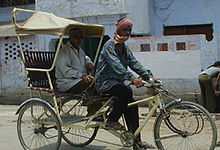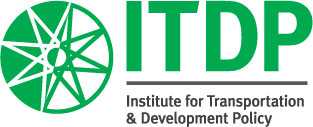Institute for Transportation and Development Policy
|
Promoting Sustainable and Equitable Transportation Worldwide. | |
| Established | 1985 |
|---|---|
| President | Enrique Peñalosa |
| Exec. Director | Walter B. Hook |
| Location | New York, NY, US (Headquarters) |
| Address | 9 E. 19th St. New York, NY |
| Website | www.itdp.org |
The Institute for Transportation and Development Policy (ITDP) is a non-governmental non-profit organization that seeks to reduce greenhouse gas emissions and improve the quality of urban life by advancing sustainable transportation in cities around the world. ITDP provides technical assistance to cities and local advocacy groups on a range ofsustainable transportation and development issues.[1][2] ITDP focuses primarily on developing bus rapid transit (BRT) systems, promoting biking, walking, and non-motorized transport, and improving urban development platforms.[3] Other programs include parking reform, traffic demand management, and global climate and transport policy. According to its mission statement, ITDP is committed to "promoting sustainable and equitable transportation worldwide."[2]
In addition to its role supporting and consulting local governmental efforts to develop more sustainable transportation, ITDP publishes the magazine Sustainable Transport annually, produces the BRT Standard and other research, and sits on the committee for the annual Sustainable Transport Award.
Overview
Founded in 1985, ITDP was created by a group of sustainable transport advocates in the United States to counteract the spread of costly and environmentally damaging car-centric urban development models, and promote alternative transit in transportation planning.[4][5][6]
In its first ten years, ITDP worked to support and grow local bicycle industry in Haiti, Nicaragua, Mozambique, South Africa, and West Africa. In addition, ITDP advocated for the redirection of lending activity by the World Bank and other multi-lateral institutions. Where these global institutions had an exclusive focus on road projects, ITDP worked to open up funding for multi-modal transport solutions.[6] In the early nineties, ITDP helped establish the Transport Sector Task Force, an advisory panel to the US Treasury Department's Multi-lateral Development Bank liaison office, to comment on specific transport projects. In its 1994 study "Counting on Cars, Counting Out People" ITDP published a preliminary set of guidelines for reforming the World Bank Transport Sector economic appraisal to make it less biased in favor of motorways. The report's key recommendation that economic impacts on non-motorized road users be included in the appraisal has been incorporated into World Bank practice.[7]
ITDP has offices in seven countries, with projects and relationships in over 100 cities worldwide.[8]
In 2009 Enrique Peñalosa, former mayor of Bogotá, Colombia, who has received wide acclaim for making the city of Bogotá a "model of enlighted planning" during his four-year tenure, and was instrumental in the establishment of that city's exemplary TransMilenio BRT system, was elected as President of the Board of Directors of ITDP.[9][9][10] Walter B. Hook has served as the organizations executive director since 1993.
Key areas of operation
Public transport
ITDP works to encourage safe, modern, and efficient public transportation systems in cities worldwide. ITDP is currently active in a design and/or consulting capacity in the BRT programs of Ahmedabad, India; Dar es Salaam, Tanzania; Johannesburg, South Africa (Rea Vaya); Jakarta, Indonesia (TransJakarta); Guangzhou, Lanzhou, and Yichang, China; Mexico City, Mexico, Buenos Aires, Argentina, and more.[11]
In June 2007, ITDP published the Bus Rapid Transit Planning Guide along with the United Nations Environment Programme, the Deutsche Gesellschaft für Technische Zusammenarbeit (GTZ), the Hewlett Foundation, and Viva. The guide draws from the extensive BRT design experience of Latin American transit planners, and aims to disseminate this information in the US and other countries around the world.[12] The guide is currently available in English, Spanish, Portuguese, and Chinese, and is free for download in .pdf format from the ITDP website.[12]
In addition, ITDP developed the BRT Standard, a design guide and rating system for Bus Rapid Transit systems around the world. The Standard establishes a common definition for BRT and identifies BRT best practices, as well as functioning as a scoring system to allow BRT corridors to be evaluated and recognized for their superior design and management aspects. It uses a systematic method of evaluating BRT systems, rating their quality as "gold, silver, or bronze". Some systems that had been branded as BRT failed to meet even minimal standards distinguishing BRT from regular urban bus service. A related report on BRT in the US[13] noted that "Some American systems reviewed had so few essential characteristics that calling them a BRT system at all does a disservice to efforts to gain broader adoption of BRT in the United States...These systems, with relatively few BRT characteristics, have helped confuse the American public about what exactly constitutes BRT."[13]:34
Cycling and walking
ITDP encourages urban design that prioritizes human-powered forms of transportation, such as walking, cycling, and the use of rickshaws. Specifically, ITDP often works with cities to encourage car-free days and bike share programs, create safe streets for pedestrians and cyclists, and provide high-quality bicycles.[14]

In December 2013 the ITDP published the Bike-Share Planning Guide with the aim "to bridge the divide between developing and developed countries’ experiences with bike-share." The guide is expected to be useful for planning and implementing a bike sharing system regardless of the location, size, or density of the city. The guide is currently available only in English and is free for download in .pdf format from the ITDP website.[15]
ITDP works with local governments on the expansion and design of bike lanes, and pedestrian networks throughout the city. In São Paulo, Brazil ITDP assisted in the design of a pilot bicycle path in the neighborhood of Butantã. For the project, ITDP commissioned a report for a 58 kilometer feeder network, which will lead cyclists from adjacent streets and sidewalks to the bicycle path. The path will pass through a high-visibility corridor of the city, and if successfully implemented could be expanded to surrounding neighborhoods and throughout the city.[16]
Past projects have included a redesign of India's traditional cycle rickshaw in collaboration with local experts, reducing the weight of the vehicles by 30% and adding a multi-gear system to increase efficiency; increasing Africa's cycling capacity while bolstering local industry through the establishment of the California Bike Coalition (CBC); and traffic impact and mitigation analysis along with outreach to local interest groups in the pedestrianization of Malioboro Road in Yogyakarta, Indonesia.[17][18][19][20]
Sustainable urban development
ITDP works to integrate transport and smart urban design to help remake cities and suburbs into livable spaces that foster economic opportunities, encourage low carbon lifestyles, and attract residents. This is done through designing environments for cycling and walking, fostering the development of pedestrian and transit based real estate development, and creating policies that help turn cultural and physical spaces into economic assets.[21]
In November 2013 ITDP published "The TOD Standard" which elaborates in eight key principles for guiding the implementation of transit-oriented development (TOD). The guide is available for download in .pdf format from the ITDP website.[22]
ITDP has initiated advised on a number of projects in cities around the world. ITDP worked with the Mexico City government to provide technical support for the revitalization of Mexico City's Historic Center. ITDP managed the planning and implementation efforts of the revitalization, in addition to promoting street maintenance and cleanliness, supplementation of public security, and the management and controlling of parking and street vending activity in the area. ITDP claims that this reorientation of the Historic Center towards pedestrian and transit oriented development will reverse decades of deterioration, attract tourism and investment, and improve air quality in the notoriously polluted city. Additionally, ITDP participated as part of the team developing Mexico City’s Bicycle Master Plan to design routes that connect to the Historic Center, further integrating multi-modal development of the area.[23]
See also
- BRT creep
- BRT Standard
References
- ↑ "Keeping Buses on the Left May Not Work" by Atul Mathur, Hindustan Times, New Delhi, May 15, 2008
- ↑ 2.0 2.1 "ITDP Website". Itdp.org. 1999-02-22. Retrieved 2014-05-23.
- ↑ ITDP: Our Program Areas
- ↑ ITDP: Who We Are
- ↑ "Former Mayor of Bogota Stumps for Congestion Pricing" by Matthew Schuerman, WNYC, Feb 18, 2008
- ↑ 6.0 6.1 "Rethinking the auto: Blueprints for a cleaner, greener future" by Michael Reiner, Utne Reader, March/April 1989
- ↑ Hook, Walter. Counting on cars, counting out people: a critique of the World Bank's economic assessment procedures for the transport sector and their environmental implications, Institute for Transportation and Development Policy, 1994.
- ↑ "USAID PVO Registry". Pvo.usaid.gov. 1994-12-21. Retrieved 2014-05-23.
- ↑ 9.0 9.1 Enrique Peñalosa Elected ITDP President
- ↑ "Man With a Plan" by Deborah Solomon, New York Times Magazine, June 8, 2008
- ↑ ITDP: Current Projects
- ↑ 12.0 12.1 "Bus Rapid Transit Planning Guide". ITDP: Institute for Transportation and Development Policy. Institute for Transportation and Development Policy. Retrieved 2014-05-23.
- ↑ 13.0 13.1 "Recapturing Global Leadership in Bus Rapid Transit: A Survey of Select U.S. Cities". ITDP: Institute for Transportation and Development Policy. Institute for Transportation and Development Policy. Retrieved 2014-05-23.
- ↑
- ↑ The Bike-Share Planning Guide, ITDP, (English), 2013.
- ↑ ITDP: São Paulo Bicycle Planning
- ↑ "The Institute for Transportation and Development Policy: Making Bicycling Work for Millions in the Developing World" by Ryan Morris, American Cyclist, Spring 2001
- ↑ "Pedestrianization in Yogyakarta: Transforming the Malioboro One Step at a Time". ITDP. December 1, 2005. Retrieved 2013-04-21.
- ↑ India Rickshaw Modernization
- ↑ California Bike Coalition (CBC)
- ↑ ITDP: Making Cities Desirable Places to Live Again
- ↑ "TOD Standard". https://www.itdp.org/tod-standard/''. ITDP.
- ↑ ITDP: Mexico City Center Revitalization
